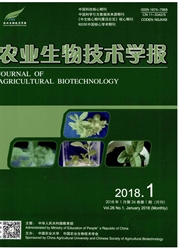

 中文摘要:
中文摘要:
DNA甲基化是表观遗传调控的重要组成部分,在真核生物的基因表达调控中发挥了重要作用。本实验研究了感受0、6、12、18和24d4℃低温的牡丹(Paeonia suffruticosa)鲁荷红移入温室后的萌动和开花表现,并对其进行了甲基化敏感扩增多态性(methylation sensitive amplified polymorphism,MSAP)分析。结果表明,4℃低温处理18d可解除鲁荷红内休眠,继续增加低温则进入生态休眠阶段。MASP分析表明,牡丹内休眠期间花芽内DNA甲基化程度很高,甲基化位点占总位点比率的60%以上,以半甲基化为主,在低温处理进程中,甲基化水平总体呈下降趋势。与未经低温的对照相比,约50%的位点发生了甲基化模式变化,低温6、12、18和24d去甲基化位点数和比例分别为97(17.1%)、104(18.6%)、148(24.6%)和218(36.1%),过甲基化的位点数分别为197(34.7%)、137(24.6%)、95(15.8%)和79(13.1%)。研究结果提示,DNA甲基化参与了牡丹内休眠的调控。
 英文摘要:
英文摘要:
DNA methylation is an important component of the epigenetic network, and it plays a very important role in regulating gene expression. This paper aims to analyze the variation of methylation patterns during chilling induced endo-dormancy release process in tree peony(Paeonia suffruticosa), which will help to isolate and identify methylation regulating genes during dormancy release. The morphological changes of Luhehong enduring 0, 6, 12, 18 and 24 d of 4℃ chilling were observed to ascertain the stages of dormancy after transferred to greenhouse(18~22℃/10~18℃, 8 h light/ 16 h-dark cycle). The accumulation of chilling had a significant effect on the percentage of buds break and also florescence. As the amount of chilling accumulation increased, the percentage of bud break and florescence increased with faster germination. When exposed to less than 18 d of chilling, the percentage of bud break and flower was low, but after 18 d nearly 100% of the buds broke and finally flowered, and no difference between 18 and 24 d of chilling (P0.05). Therefore, physiological status of flower bud receiving less than 18 d chilling fulfilling was defined as endo-dormancy, and that receiving more than 18 d chilling treatment was designated as eco-dormancy. DNA methylation patterns were subsequently analyzed by methylation sensitive amplified polymorphism (MSAP) technology with 32 pairs of primer combination with EcoR Ⅰ and HpaⅡ/MspⅠ. Totally, 3 181 bands were amplified, averaging 99.4 bands per primers pair. The results showed that the level of methylation in dormancy buds was extraordinary high, and all exceeded 60%, among which hemi-methylation was dominant. The levels of hemi-methylation and fully methylation fluctuated during chilling duration. However, the level of total DNA methylation was down-regulated during bud dormancy release except a peak at 18 d chilling, and the methylation levels of 0, 6, 12, 18 and 24 d chilling were 78.6%, 76.3%, 74%, 79%, and 61.8% respectively. About 50% methylation sit
 同期刊论文项目
同期刊论文项目
 同项目期刊论文
同项目期刊论文
 期刊信息
期刊信息
